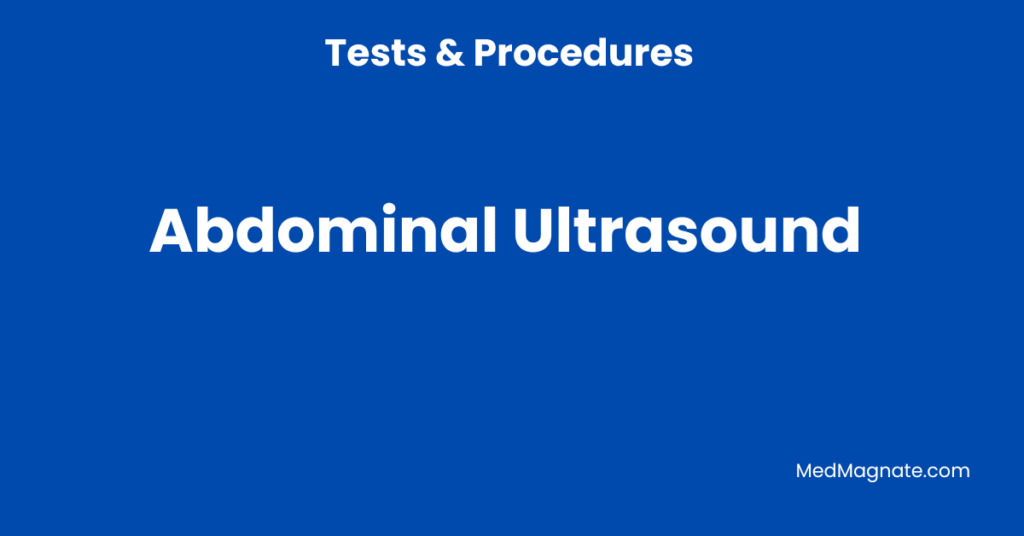An abdominal ultrasound is a simple, painless imaging test that uses sound waves to create pictures of the organs in your abdomen. It helps doctors check the liver, kidneys, gallbladder, pancreas, spleen, and blood vessels.
It is a safe and non-invasive method to detect abnormalities without radiation exposure.
What is an Abdominal Ultrasound?
An abdominal ultrasound uses high-frequency sound waves to produce images of internal organs. The sound waves bounce off organs and tissues, and a computer converts them into pictures on a screen.
It helps doctors see:
- Size and structure of organs
- Presence of cysts, tumors, or stones
- Fluid accumulation
- Blood flow in major vessels
Why is an Abdominal Ultrasound Done?
Abdominal ultrasound is used for many reasons:
- Detecting Gallstones or Kidney Stones: Checks for stones causing pain or obstruction.
- Liver Conditions: Fatty liver, cirrhosis, or tumors.
- Pancreatic Problems: Inflammation, cysts, or tumors.
- Kidney Diseases: Kidney size, cysts, or blockages.
- Abdominal Aneurysm: Checks blood vessel enlargement.
- Unexplained Abdominal Pain: Helps find the cause of pain, swelling, or bloating.
- Monitoring Existing Conditions: For ongoing diseases like liver or kidney disorders.
How to Prepare for an Abdominal Ultrasound
Proper preparation ensures clear and accurate images:
- Fasting: Usually, avoid food and drinks (except water) for 6–8 hours before the test.
- Bladder: Sometimes, a full bladder is required, especially for pelvic ultrasound.
- Clothing: Wear loose, comfortable clothing. You may be asked to remove tight clothes or jewelry around the abdomen.
- Medical History: Inform your doctor about current medications or recent surgeries.
How is the Procedure Done?
- You lie down on an examination table.
- A special gel is applied to your abdomen to help sound waves pass through the skin.
- A transducer (small handheld device) is moved over your abdomen.
- Images appear on a monitor in real-time.
- The procedure usually takes 15–30 minutes and is painless.
What to Expect After the Test
- You can resume normal activities immediately.
- The gel is wiped off after the test.
- Your doctor will review the images and discuss the results.
Benefits of Abdominal Ultrasound
- Non-invasive and safe – No needles or radiation.
- Quick and painless – Usually completed in under 30 minutes.
- Accurate imaging – Helps diagnose a wide range of abdominal conditions.
- Guides treatment – Assists in planning surgeries, biopsies, or other procedures.
Limitations of Abdominal Ultrasound
- May not detect very small tumors or deep tissue problems.
- Gas in the intestines can make imaging less clear.
- Obesity may reduce image quality.
Conclusion
An abdominal ultrasound is a safe, non-invasive test that helps doctors examine abdominal organs and diagnose diseases like stones, cysts, tumors, and organ abnormalities.
Proper preparation improves image quality, and the procedure is painless and quick.
FAQs
Q 1. Is an abdominal ultrasound safe?
Yes, it is completely safe and does not use radiation.
Q 2. Do I need to fast before an abdominal ultrasound?
Yes, usually 6–8 hours of fasting is recommended for accurate results.
Q 3. How long does the test take?
Typically 15–30 minutes.
Q 4. Can an ultrasound detect liver problems?
Yes, it can detect fatty liver, cirrhosis, tumors, and other liver abnormalities.
Q 5. Does the test hurt?
No, it is painless. You may feel slight pressure when the transducer moves over your abdomen.
Q 6. Can it detect kidney stones?
Yes, ultrasound can detect stones, blockages, and kidney abnormalities.
Q 7. When will I get the results?
Results are usually available within a few hours to a few days, depending on the facility.

